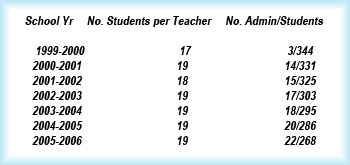CSHS may be ‘excelling’ but it doesn’t make U.S. News & World Report top 100 list
By Linda Bentley | December 17, 2008
CCUSD – U.S. News & World Report issued its 2009 list of “America’s Best High Schools,” using methodology developed by School Evaluation Services (SES), Standard & Poor’s K-12 education research affiliate.
Despite its “excelling” label, Cactus Shadows High School didn’t make the list. It didn’t even garner an honorable mention.
SES analyzed 21,069 public high schools in 48 states, basing its evaluation on the “key principles that a great high school must serve all its students well, not just those who are bound for college and it must be able to produce measurable academic outcomes to show that the school is successfully educating its student body across a range of indicators.”
It used a three-step process, the first two of which ensured schools served all their students well by using state proficiency standards to measure benchmarks. The third step assessed to what degree students were prepared for college-level work.
SES posts the analyzed data in an easily searchable database at www.schoolmatters.com, allowing users to compare schools with others in the same city or anywhere across the country.
Another database www.great schools.com offers similar, sortable data.
Sonoran News was curious as to why high schools in neighboring school districts, also labeled excelling, made the USN&WR list, while CSHS did not.
Chaparral High School, in the Scottsdale Unified School District, and Horizon High, in the Paradise Valley Unified School District, both made the list with “silver” rankings, using SES’ three-tier, bronze, silver and gold Olympics-style rating system.
Horizon and Chaparral both had higher scores than CSHS in reading and math proficiency even though Horizon’s per-student spending was hundreds less than CSHS and Chaparral was only slightly higher than CSHS.
Horizon had the highest number of students per teacher at 25, while both CSHS and Chaparral had 21 students.
All three schools had pretty much the same demographic make-up, with 90 percent of their students reported as white.
Chaparral and Horizon beat CSHS in both reading and math proficiency as follows:
Reading: CSHS 88.0%; Chaparral 94.1%; Horizon 93.4%.
Math: CSHS 81.2%; Chaparral 96.2%; Horizon 87.0%.
The amount of money spent per student obviously was not an issue, as schools with less money per student had better scores and made the USN&WR list of Arizona’s top 100 high schools.
After further analysis, it appeared not to be the amount of money spent per student, but the amount of money spent in the classroom.
CSHS spends only 54 percent of its money in the classroom, which is below the state average of 56 percent.
Every single one of the other Arizona schools that made the USW&NR list spent more in the classroom than CSHS, most allocating 60 percent. Even schools that received hundreds less per student than CSHS spent hundreds more in the classroom.
Also telling is the ratio of students to teachers and administrators to students at CSHS.
The numbers in the chart below were submitted by the district to the state superintendent’s office in annual reports.
District taxpayers have been told budget overrides are necessary to reduce class size. However, in reality, as overrides have come and gone, the number of administrators has increased significantly in proportion to the number of students, while the number of students per teacher has remained stagnant over the past several years.

